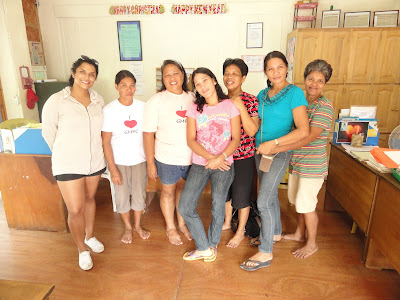 |
| The Ladies of GMPC |
The island of Bantayan, north west of Cebu Island, can only be described as quaint and idealistic. With no big vehicles or many cars on the road, the best way to get around the island is by bicycle, scooter or motorbike. So we rented a scooter and went on a bit of a wonder around the island, with our midway stop being the Guiwanon Multi Purpose Cooperative, or GMPC.
The journey was stunning. The day before, a storm had hit
the neighbouring islands of Negros and Mindano, but Bantayan seemed to have
been little effected. Our ride past mangroves and up along the coast was our
first glimpse at an Island economically sustained by the fishing industry. It
was a little surprise that the women we were on our way to meet, were utilising
this abundance of fresh fish to produce a product for sale that captures the
taste of Bantayan’s best: Spanish style sardines in oil.
Our arrival was greeted with warm smiles and even warmer hugs.
We were shown around the GMPC’s community building, built and developed by the
Justic Peace and Integrity of Creation- Integrated Development Center, INC
(JPIC-IDC), a Christian NGO working in the Cebu region. JPIC helped the women
of Guiwanon to develop business skills, they also provided them with training in agricultural
sustainability, and helped in bringing the community together with a project
aimed at empowering women in rural areas.
 |
| The GMPC Community Building |
The community building had a shop, offices, a dinning venue, a conference room and a purpose built kitchen that the women could use in their business endeavours. We sat in the kitchen whilst the women finished of sealing and labelling some 93 bottles for shipment, and we realised the simplicity of the operation. There was nothing complicated about the process, it was a few simple steps from having fresh sardines to having preserved sardines that would last on a shop shelf for months to come. It was the training in health and safety and in quality control, which was the most important thing the women had learnt, and to put it into practice for their products to be marketable on a wider scale.
 |
| The Kitchen where the sardines are produced |
The women told me they bought their fish from the same
fisherman every time, and assured me he practised environmentally friendly fishing
methods. Along with the sardines, there are chillies, carrots, bay leaves and
peppercorns in the preserve. The women told me all the produce comes from their
gardens.
Along with the sardines, the women also produced Kropic. A
rice cracker, which is dried to be preserved and then fried just before eating.
They women made kropic in four different flavours: carrot, mulugay, squid, and
shrimp. The weather needed to be hot and sunny in order to make the kropic as
it requires drying in the sun for the whole day. But as unfortunately the rainy
seasons were prolonging, the production of kropic had to be put on hold.
 |
| Left to right: Carrot kropic and mulungay kropic |
So it was time for, what I consider the best bit… the tasting!!! We got some bread, fried some kropic and opened a jar of sardines and dug in! I can’t say I’ve ever been a fan of sardines unless they were deep fried in batter, but these little shiny beauties were delectable. They had a lovely yet very mild flavour. I asked the ladies how they preferred to eat the sardines, and some suggestions were: fried and with noodles, with rice, in a sandwhich and ground up with liver as an accompliment to a meal. One women said here mother in-law liked then in her Lumpia (kind of like a large spring roll).
I really enjoyed meeting the women of GMPC. I personally
felt they were living a decent life, where they were empowered to make their
own living, help others in the community, and to stand an example of successful
rural development. Programmes like this give people a chance, and shows that
community improvement and development is they way forward to a better life, not
moving to the city as many people see as a way of escaping problems. A lot of
farmers and fishermen in the Philippines are moving to the cities to find jobs,
due to crop failure, land disputes, visions of riches and even because of
climate change problems. My visits to small producers has shown me that there
are ways of making a living in rural Philippines with the right help and with
more of an integration within village/town communities. Obviously the right guidance is needed,
and people need to see the benefits before part embarking on a project. But as
I have seen: with the right support, the hope and the driven determination for
a better future, this is the happenings for a better Philippines.
On the way back, we stopped for a swim in the sea to watch
the sunset. I can’t even begin to tell you how beautiful Bantayan and how
lovely the people are. I really recommend a visit. Enjoy the quite beaches, the
local cuisine and the beautiful sunsets. It’s unspoilt and far from the crowds.
It’s my heaven on earth : )




pretty looking and beautiful posting.
ReplyDelete